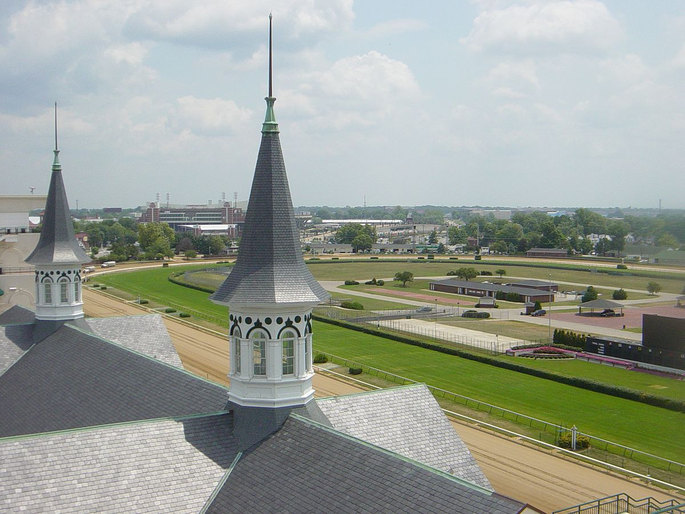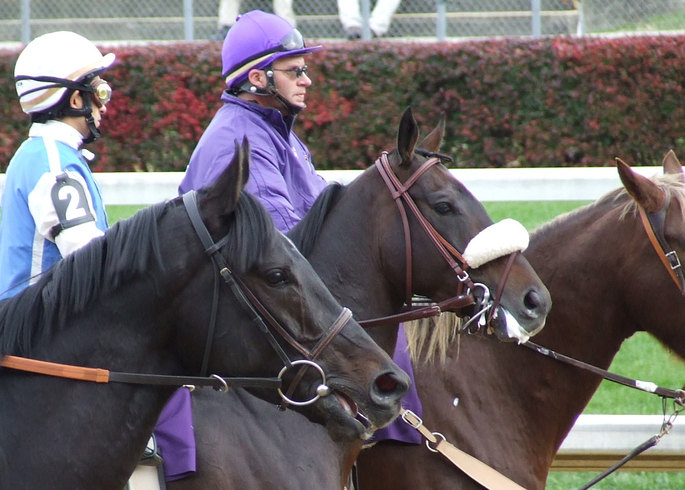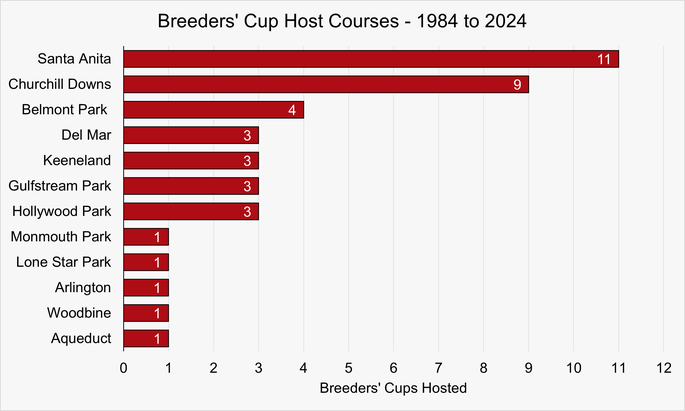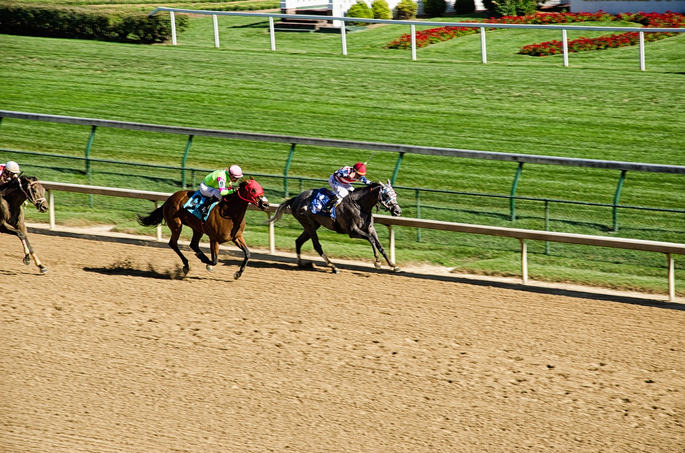Fast Facts
- When: 1st & 2nd November 2024
- Where: Del Mar, California, USA
- Watch: ITV, At The Races
- Official Website: Breeders' Cup
The Breeders’ Cup is a two-day flat horse racing meeting held annually in North America. Its exact location changes each year with courses such as Churchill Downs and Santa Anita amongst the host courses. With championship or ‘Breeders’ Cup Trophies at a number of distances as well as on both dirt and turf, this meeting attracts the best racehorses in training from around the globe competing for the huge prize funds which together total nearly $30 million.
The main event of the meeting is the Breeders’ Cup Classic which is run over 1 1/4 miles as the final race of the festival on the Saturday. We preview this below giving our predictions as well as showing you the best promotions the bookies are offering.
Existing Customer Free Bets & Money Back Offers
Note: Offers will appear here nearer the event as and when they become available.
About The Breeders’ Cup

Whilst the title might make it sound like a one-off race, the Breeders’ Cup is actually a run of Grade 1 here races that take place in the United States over a two day period.
Unlike many horse racing events, which can often trace their history back hundreds of years, the Breeders’ Cup has only been going since 1984. The idea for the event was suggested by the heir of a pet food chain, John R. Gaines. He made his proposal at the luncheon for the awards in the wake of the 1982 Kentucky Derby Festival, keen to try to clean up the image of racing that had taken a bit of a beating in the preceding years.
Despite Gaines being both a thoroughbred owner and breeder, it wasn’t until a legendary trainer by the name of John Nerud leant it his support that the Cup began to gain the respect of the horse racing community. The result of that initial idea, voiced in the wake of one of America’s most successful races, was the formation of Breeders’ Cup Limited, a company with the specific aim of starting a series of races specifically aimed at thoroughbred race horses.
Expansion and Development of the Meeting

By Lee Burchfield, flickr (cropped)
For the first twenty-two years of the Breeders’ Cup, it was specifically a one day event. It wasn’t until the arrival of Greg Avioli as interim President and CEO of Breeders’ Cup Limited that that began to change. From reasonably early on in the Cup’s existence it had managed to attract a significant number of thoroughbred horse owners from Europe, which Avioli decided the company should try to capitalise on. He began to put feelers out regarding the possibility of expanding the event to two days, with enough people lending him their support to mean that he became the company’s CEO permanently in 2007.
Immediately the event was expanded to cover two days and the year after he became CEO Breeders’ Cup Limited chose to make the first day one exclusive to female horses. In order to attract both TV audiences and sponsors, the overall purse rose to $25 million and earned itself the tagline ‘the richest turf festival in the world’ from the New York Post. Day two boasted a purse of $17 million in 2008, which was actually three million less than it had managed the year before because two of the races had been shifted to day one. 2008 was also the first year that the majority of the races were run on an artificial surface instead of a dirt one, making something of a mockery of the New York Post’s tagline for it.
Colour Coded Saddle Cloths
In 1985 the Breeders’ Cup decided to use purple saddle towels, which became something of an iconic image of the meeting. The purple towels replaced yellow ones that had been used in the inaugural year and they remained in place even when the rest of the horse racing fraternity in North America moved to a colour-coded system in the 1990s. In 2009, however, the Breeders’ Cup caught up with the rest of the country by taking on the coded system. It was a break in tradition with many more to follow, not least of which was the start of televising the event to national and international bettors for the first time.
Betfair Broadcast & The Breeders’ Cup Challenge
In January of 2009 the betting company Betfair had bought the US horse racing network named TVG. By October of that year the Breeders’ Cup confirmed that it had made an agreement to simulcast and licence its races with the betting company, bringing in the two and a half million customers that they had. Those customers had access to legal pool betting, with Betfair broadcasting the championships in November to all of its customers. The move meant that the event became a popular one for bettors all around the world.
2009 was also the start of a new qualifying system that boasted the nickname ‘Win and You’re In’. It meant that winners of big races from countries like Hong Kong, the UK and Ireland, Japan, Australia, France and South Africa gained automatic entry into the Championship Races for the first time. In 2010 overall return was the highest that the organisation had ever managed, not least of all because betting neared $200 million. Betfair received an almost immediate return on their investment, given that over $20 million was bet with them.
The Juvenile Sprint & Medication Bans
Craig R. Fravel became the CEO and President of Breeders’ Cup Limited in 2011 and began developing aspects of the meeting. One of the first changes came in the form of adding the Juvenile Sprint to the lineup of races. The change wasn’t a popular one, however, and it was dropped for the following year’s meeting. Another unpopular decision was one that involved the banning of the anti-bleeding medication furosemide. It had already been banned by many European race meetings, but handicappers and many of the horseman objected so the ban was dropped.
Racecourses
Since the event’s first running in 1984, the Breeders’ Cup has moved location on a fairly regularly basis. It remained in America apart from in 1996 when it was hosted by Canada’s Woodbine Racetrack.

Between 2008 and 2014 the meeting was shared by Santa Anita Park and Churchill Downs, only for Keeneland Racecourse in Lexington, Kentucky to be chosen as the host venue for 2015. Many were concerned that it wouldn’t have enough room for the large crowds that liked to watch the Breeders’ Cup, but it managed a record attendance on the first day and the venue sold out on Saturday.
At least part of the reason for the success of the 2015 meeting was the fact that American Pharoah managed to win the Triple Crown for the first time since the Breeders’ Cup had been created. American Pharoah won what was known as the Grand Slam of Thoroughbred Racing, combining the Triple Crown with the Breeders’ Cup Classic. The popularity of the 2015 outing of the Breeders’ Cup at Keeneland, has led to the course being awarded hosting rights in 2020 and 2022.
Future Stars Friday Races
There are a number of races that take place over the two days of the Breeders’ Cup with the first day on Friday is known as Future Stars.
Breeders’ Cup Juvenile (Dirt)
This race is exclusively for colts and geldings that are aged two and takes place on dirt. With a purse of $2 million, it is the most valuable race for such horses in North America. It has been in place since the first Breeders’ Cup in 1984. There are usually fourteen runners and three places are given over to the winners of the American Pharoah Stakes, the Breeders’ Futurity Stakes and the Champagne Stakes.
2023 Juvenile (Dirt) Challenge Series
| Race Name (Month) | Course | Country |
|---|---|---|
| Champagne Stakes (Oct) | Aqueduct | USA |
| Breeders’ Futurity Stakes (Oct) | Keeneland | USA |
| American Pharoah Stakes (Oct) | Santa Anita | USA |
Breeders’ Cup Juvenile Turf
Inaugurated in 2007 and run left-handed, the Breeders’ Cup Juvenile Turf is, as the name suggests, for two-year-old fillies. It’s run over one mile and received Grade 2 status in 2009 and then became a Grade 1 offering two years later. It is one of the ‘Win and You’re In’ races, with six of the fourteen starting berths being given over to the winner’s of Leopardstown’s Juvenile Turf Stakes, Woodbine’s Summer Stakes, the Royal Lodge Stakes at Newmarket, The Pilgim Stakes, Keeneland’s Bourbon Stake and the Prix Jean-Luc Lagardere at Longchamp.
2023 Juvenile Turf Challenge Series
| Race Name (Month) | Course | Country |
|---|---|---|
| Champions Juvenile Stakes (Sept) | Leopardstown | Ireland |
| Summer Stakes (Sept) | Woodbine | Canada |
| Royal Lodge Stakes (Sept) | Newmarket | England |
| Prix Jean-Luc Lagardere (Oct) | Longchamp | France |
| Pilgrim Stakes (Oct) | Aqueduct | USA |
| Bourbon Stakes (Oct) | Keeneland | USA |
Breeders’ Cup Juvenile Fillies Turf
The Breeders’ Cup Juvenile Fillies Turf was run for the first time in 2008 and is similar to the Fillies Turf in so much as it’s a race for two-year-old fillies that’s run left-handed over a mile. It received Grade 2 status in 2010 and became a Grade 1 race in 2012. The ‘Win and You’re In’ races for this one are as follows:
2023 Juvenile Fillies Turf Challenge Series
| Race Name (Month) | Course | Location |
|---|---|---|
| Moyglare Stud Stakes (Sept) | Curragh | Ireland |
| Natalma Stakes (Sept) | Woodbine | Canada |
| Rockfel Stakes (Sept) | Newmarket | England |
| Prix Marcel Boussac (Oct) | Longchamp | France |
| Miss Grillo Stakes (Oct) | Aqueduct | USA |
| Jessamine Stakes (Oct) | Keeneland | USA |
Breeders’ Cup Juvenile Turf Sprint
The name tells you everything you need to know here, with the The Breeders’ Cup Juvenile Turf Sprint being a sprint race for juveniles. It was inaugurated in 2018 but was run as an undercard’s race at the Breeders’ Cup prior to then. As with the other races mentioned, this race for two-year-olds is run on a Win and You’re In’ basis and the victors in the Norfolk Stakes, Prix Morn and the Belmont Futurity Stakes at Aqueduct all get automatic entry into this race.
2023 Juvenile Turf Sprint Challenge Series
| Race Name (Month) | Course | Country |
|---|---|---|
| Norfolk Stakes (Jun) | Ascot | England |
| Prix Morny (Aug) | Deauville | France |
| Futurity Stakes (Oct) | Aqueduct | USA |
Breeders’ Cup Juvenile Fillies
Limited to two-year-old fillies, the Juvenile Fillies race is run left-handed on a dirt track. It has taken place every year since the Breeders’ Cup’s inauguration in 1984 and is raced over eight and a half furlongs. When the ‘Win and You’re In’ system was introduced in 2007, four of the race’s fourteen starting berths were given over to the winners of the Chandelier Stakes, Alcibiades Stakes and Belmont Park’s Frizette Stakes.
2023 Juvenile Fillies (Dirt) Challenge Series
| Race Name (Month) | Course | Country |
|---|---|---|
| Alcibiades Stakes (Oct) | Keeneland | USA |
| Frizette Stakes (Oct) | Aqueduct | USA |
| Chandelier Stakes (Oct) | Santa Anita | USA |
Breeders’ Cup Saturday Races
The main events for the Breeders’ Cup occur on the Saturday. In total there are nine races on the card on both dirt and turf. The day culminates in the Breeders’ Cup Classic as the final race of the meeting.
Breeders’ Cup Filly & Mare Sprint
The Filly & Mare Sprint is, as the name suggests, for fillies and mares that are aged three and over. Because it’s a sprint it’s a shorter race than many and takes place over seven furlongs. It took place for the first time in 2007 when it was run over eight furlongs because of the shape of the track at Monmouth Park where the Breeders’ Cup was held that year. There are fourteen places up for grabs in the race and winners of the Princess Rooney Handicap at Gulfstream Park, the Ballerina Stakes at Saratoga Race Course and the Thoroughbred Club of America Stakes at Keeneland Race Course get one automatically.
2023 Filly & Mare Sprint (Dirt) Challenge Series
| Race Name (Month) | Course | Country |
|---|---|---|
| Ballerina Stakes (Aug) | Saratoga | USA |
| Thoroughbred Club of America St. (Oct) | Keeneland | USA |
| Princess Rooney Stakes (Oct) | Gulfstream Park | USA |
Breeders’ Cup Turf Sprint
This race for three-year-olds and over takes place over either five or six and a half furlongs depending on where the Breeders’ Cup is being held. It’s run left-handed on a turf track and has a Weight for Age basis to it. Established in 2008, it became a Grade 2 offering in 2010 and a Grade 1 race two years later. Of the fourteen places in the race, seven are given over to the ‘Win and You’re In’ scheme, which are as follows:
2023 Turf Sprint Challenge Series
| Race Name (Month) | Course | Country |
|---|---|---|
| Jaipur Stakes (Jun) | Belmont Park | USA |
| Kings Stand Stakes (Jun) | Ascot | England |
| Nunthorpe Stakes (Aug) | York | England |
| Green Flash Handicap (Sept) | Del Mar | USA |
| Turf Sprint Stakes (Sept) | Kentucky Downs | USA |
| Flying Five Stakes (Sept) | Curragh | Ireland |
| Prix de l’Abbaye (Oct) | Longchamp | France |
Breeders’ Cup Dirt Mile
A one mile race for three-year-olds and over that run on a Weight for Age basis, the Breeders’ Cup Dirt Mile took place for the first time in 2007. Because it’s a dirt race, the tracks that are used for it aren’t always necessarily a mile in length and adjustments need to be made to cope. Up to twelve horses can take part in the race, with two spaces given over on a ‘Win and You’re In’ basis. These are for the victors in the Metropolitan Handicap at Belmont Park in New York the Pat O’Brien Stakes at Del Mar, and the Ack Ack Stakes at Churchill Downs.
2023 Dirt Mile Challenge Series
| Race Name (Month) | Course | Country |
|---|---|---|
| Metropolitan Handicap (Jun) | Belmont Park | USA |
| Pat O’Brien Stakes (Aug) | Del Mar | USA |
| Ack Ack Stakes (Aug) | Churchill Downs | USA |
Breeders’ Cup Filly & Mare Turf
A race for fillies and mares that was first run in 1999, the Filly & Mare Turf race takes place on turf, unsurprisingly. It’s raced left-handed and the distance that it’s run over is dictated by the course that the Breeders’ Cup is being run on; usually a mile and a quarter, but it’s been over as short as a mile and an eighth in the past. When it comes to the ‘Win and You’re In’ side of the race, there are nine different races that offer automatic qualification for this one. As with all other ‘Win and You’re In’ races, a horse can obviously win more than one of them which will see the extra race removed from the list of qualification races. Here are the nine from the 2023 edition:
2023 Filly & Mare Turf Challenge Series
| Race Name (Month) | Course | Country |
|---|---|---|
| Paddock Stakes (Jan) | Kenilworth | South Africa |
| Victoria Mile (May) | Tokyo Racecourse | Japan |
| Gran Premio Pamplona (Jun) | Monterrico | Peru |
| Beverley D. Stakes (Aug) | Colonial Downs | USA |
| Yorkshire Oaks (Aug) | York | England |
| Flower Bowl Stakes (Sept) | Saratoga | USA |
| Matron Stakes (Sept) | Leopardstown | Ireland |
| Prix de l’Opera (Oct) | Longchamp | France |
| Rodeo Drive Stakes (Oct) | Santa Anita Park | USA |
Breeders’ Cup Sprint
This is a Grade 1 race that was first run back when the Breeders’ Cup was inaugurated in 1984. It’s a Weight for Age offering that takes place over six miles and is open to horses agree three and over. It’s run left-handed on a dirt track and three of the fourteen open berths go to winners of races that have taken place earlier in the year. They are the following:
2023 Sprint (Dirt) Challenge Series
| Race Name (Month) | Course | Country |
|---|---|---|
| Bing Crosby Stakes (Jul) | Del Mar | USA |
| Vosburgh Stakes (Sept) | Belmont at Aqueduct | USA |
| Phoenix Stakes (Oct) | Keeneland | USA |
Breeders’ Cup Mile
The name of this Grade 1 race tells you all of the important information, which is that it takes place over a mile. It’s for three-year-olds and over and is run left-handed on turf. There is a Weight for Age element to the race that was inaugurated in 1984 with the Breeders’ Cup itself. In 2007 the purse increased from $1.5 million to $2 million, making it one of the richest races of the two day festival. The ‘Win and You’re In’ aspect of the Breeders’ Cup sees up to eleven places given over to winners of previous races, which were the following in 2023:
2023 Mile (Turf) Challenge Series
| Race Name (Month) | Course | Country |
|---|---|---|
| L’Ormarins Queen’s Plate (Jan) | Kenilworth | South Africa |
| Gran Premio Club Hipico Falabella (May) | Santiago | Chile |
| Shoemaker Mile (May) | Santa Anita Park | USA |
| Yasuda Kinen (Jun) | Tokyo Racecourse | Japan |
| Queen Anne Stakes (Jun) | Ascot | England |
| Sussex Stakes (Jul) | Goodwood | England |
| Fourstardave Handicap (Aug) | Saratoga | USA |
| Prix Jacques Le Marois (Aug) | Deauville | France |
| Woodbine Mile (Sept) | Woodbine | Canada |
| Coolmore Turf Mile (Oct) | Keeneland | USA |
| Queen Elizabeth II Stakes (Oct) | Ascot | England |
Breeders’ Cup Distaff
One of few races where the name doesn’t give you much information, the Breeders’ Cup Distaff is for fillies and mares that are three or over. It’s run left-handed on a dirt track and usually takes place over nine furlongs. It was established in 1984 and for the first three years it was a quarter of a mile shorter. Four of the fourteen places up for grabs go to ‘Win and You’re In’ victors of these races:
2023 Distaff (Dirt) Challenge Series
| Race Name (Month) | Course | Country |
|---|---|---|
| Gran Premio Criadores (May) | Palermo | Argentina |
| Ogden Phipps Stakes (Jun) | Belmont Park | USA |
| Clement L. Hirsch Stakes (Aug) | Del Mar | USA |
| Spinster Stakes (Oct) | Keeneland | USA |
Breeders’ Cup Turf
The penultimate race we’ll tell you about is the Breeders’ Cup Turf, which takes place left-handed on a turf course. It’s for three-year-olds and over and is run on a Weight for Age basis, with the weights differing depending on the age of the horse and where they’re from. This is another of the races that’s been in place since 1984, though it is based on a race called the Washington, D.C. International Stakes that was inaugurated at Laurel Park Racecourse in 1952. It’s raced over a mile and a half and in 2023 eleven races were used for the ‘Win and You’re In’ qualification criteria. These were:
2023 Turf Challenge Series
| Race Name (Month) | Course | Country |
|---|---|---|
| Gran Premio Internacional Carlos Pellegrini (Dec) | San Isidro | Argentina |
| Grande Premio Brazil (Jun) | Gavea | Brazil |
| Prince of Wales’s Stakes (Jun) | Ascot | England |
| Takarazuka Kinen (Jun) | Hanshin | Japan |
| King George VI & Queen Elizabeth Stakes (Jul) | Ascot | England |
| Sword Dancer Stakes (Aug) | Saratoga | USA |
| Del Mar Handicap (Sept) | Del Mar | USA |
| Irish Champion Stakes (Sept) | Leopardstown | Ireland |
| Kentucky Turf Cup (Sept) | Kentucky Downs | USA |
| Prix de l’Arc de Triomphe (Oct) | Longchamp | France |
| Champion Stakes (Oct) | Ascot | England |
Breeders’ Cup Classic
First run in 1984 when the Breeders’ Cup itself was created, the Classic is considered by many to be the elite race for thoroughbreds in the United States. The Pegasus World Cup, the Dubai World Cup and the Prix de l’Arc de Triomphe are the only races that have consistently offered higher purses than the Classic, though the fact that the Breeders’ Cup race is so hard to predict makes it much more appealing to many bettors.
The Classic is the race that winners of the Triple Crown hope to have a victory in in order to seal the so-called Grand Slam of Thoroughbred Racing. A horse named Sunday Silence came close to achieving this in 1989 but missed out on one of the Triple Crown races, so when American Pharaoh did it in 2015 he became the first horse to pull it off.
the Classic is run left-handed on a dirt course and usually lasts for a mile and a quarter. Horses must be three and over to be able to take part in the race, with four-year-olds and over given one hundred and twenty-six pounds and three-year-olds given a weight of one hundred and twenty-two pounds if they’re form the northern hemisphere and one hundred and seventeen if they’re from the southern. Mares and fillies get an allowance of three pounds.
2023 Classic (Dirt) Challenge Series
| Race Name (Month) | Course | Country |
|---|---|---|
| February Stakes (Feb) | Tokyo Racecourse | Japan |
| Stephen Foster Stakes (Jul) | Churchill Downs | USA |
| Haskell Stakes (Jul) | Monmouth Park | USA |
| Whitney Stakes (Aug) | Saratoga | USA |
| Juddmonte International Stakes (Aug) | York | England |
| Jockey Club Gold Cup (Sept) | Saratoga | USA |
| Pacific Classic Stakes (Sept) | Del Mar | USA |
| Awesome Again Stakes (Sept) | Santa Anita | USA |
Interesting Facts

The interesting thing about the Breeders’ Cup is that it’s made up of so many different races, meaning that there are interesting things that can be said about all of them. Here are some of the standout facts from the two days of thoroughbred racing:
- The only time that the Breeders’ Cup had been held outside of the US was when Woodbine Racetrack in Canada hosted it in 1996
- The Breeders’ Cup Classic, which is the premier race of the week, has only been won more than once by one horse – Tiznow in 2000 and 2001
- When it comes to the origin of the Breeders’ Cup Classic winner, the United States has produced more than any other nation, followed by Ireland and then Great Britain
- Santa Anita Park has the honour of hosting the Breeders’ Cup the most times with eleven (up to 2023), two ahead of Churchill Downs
- Mike Smith with twenty-seven wins is the event’s most successful jockey, whilst D. Wayne Lukas’ twenty wins make him the most successful trainer
- With the exception of the Dirt Mile that has twelve, all races at the Breeders’ Cup have fourteen starters
